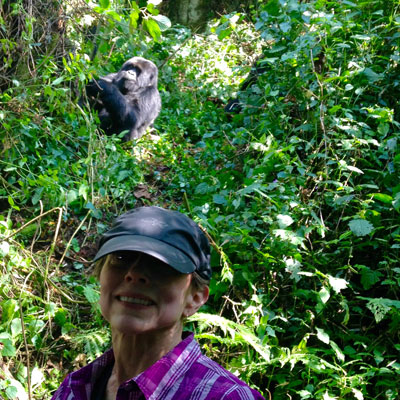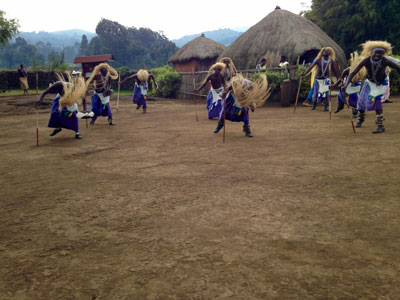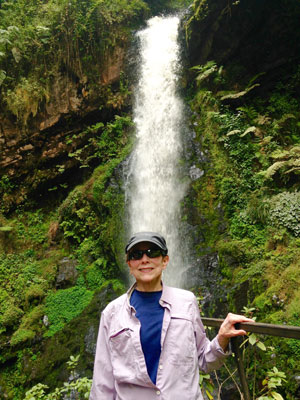Rwanda – finding more than mountain gorillas
This article appears on page 46 of the August 2016 issue.
For years I dreamed of seeing the mountain gorillas in Rwanda, creatures with whom we humans share almost 98% of our nuclear DNA. I also was intrigued by Rwanda’s social and economic recovery following the devastation from the 1994 genocide.
After more than 30 years of working as a custom travel agent, I left the travel industry without realizing this dream. In 2015, I finally arranged an extraordinary and memorable trip.
Making plans
I contacted many companies in my search for a custom tour. After receiving warm, knowledgeable, prompt and complete replies from Danny Bizimana, owner of Bizidanny Tours (Kigali, Rwanda; phone +250 [0] 788501461, www.bizidanny.com), I quickly decided that Bizidanny was the ideal tour operator for me.
The trip arrangements were perfect. I was in Rwanda Aug. 5-12, and the cost of $7,000, single occupancy, included seven nights in four hotels; all meals except two dinners; two hikes; a driver/guide for the entire trip; transportation in a comfortable Toyota Land Cruiser, and permits to see the mountain gorillas twice ($750 per day).
I arranged my own flights, booking KLM round trip from New York’s JFK to Kigali via Amsterdam. The air travel was seamless, and my Bizidanny guide, Jeremiah Muhire, greeted me warmly at the airport and drove me to my overnight accommodation, the Kigali Serena Hotel.
The hotel staff was welcoming and gracious, and my room was cozy and comfortable, including good Wi-Fi and a delicious room-service breakfast the next day.
Into the forest
In the morning, we traveled approximately six hours to Nyungwe Forest National Park, stopping in Butare for lunch. I enjoyed seeing more of the mountainous countryside, which was more populated than I had expected — with people walking and biking, often carrying water or produce.
I spent three nights at the deluxe Nyungwe Forest Lodge, set in the midst of a tea plantation on the edge of the Nyungwe Forest and surrounded by a vibrant-green landscape of fields and mountains.
The accommodations were in spacious bungalows, each with a huge bathroom with double sinks and a separate tub and shower plus a balcony overlooking the rainforest. The meals were Continental, with plenty of choices, and the friendly staff personalized my food requests and remembered my preferences.
The staff at the lodge, who acknowledged each request graciously, epitomized the warm and friendly service I experienced throughout Rwanda. The lodge’s peace and serenity was a great way to start my trip.
Nyungwe is a pristine, almost untouched, mountainous rainforest rich in biodiversity. I explored some of the forest on a guided canopy walk, which offered expansive views, and took a 10k waterfall hike, enjoying close-up views of the primeval plants reminiscent of “Jurassic Park”!
Nyungwe was a beautiful place to recover from jet lag and acclimate to the higher altitudes (approximately 6,000 feet in Kigali and 6,500 feet at Nyungwe) in preparation for hiking at 7,000 to 9,000 feet to see the mountain gorillas.
Volcanoes National Park
During the 7-hour drive to Volcanoes National Park, I was never bored. A portion of the winding road — with mountains, hills and an occasional view of Lake Kivu — was under construction, which made the trip feel like a great adventure.
When we stopped, people walking by were friendly, but most adults did not linger. Children appeared more curious, waving at us everywhere we went and adding to my sense that this was going to be a special trip. On my next trip, I will take some books or pens to offer to the kids as gifts.
At one small town, Jeremiah introduced me to his older brother, who had fought against the genocide as a member of the military, in which he still serves as a district leader.
At Volcanoes National Park, I stayed at the Mountain Gorilla View Lodge, near the park headquarters, for two nights. The lodge was comfortable and casual — ideal as a base for seeing the mountain gorillas.
Most of the buffet-style meals included pasta, rice or potatoes, with stir-fry dishes made to order at dinner and omelets at breakfast.
The rooms were in separate bungalows, each with a fireplace, a sofa and space for at least four people (although mine had only one bed).
Every evening, the staff lit the fireplace in my room, as it was chilly. I appreciated that the showers had plenty of hot water — much needed for relaxing after hiking.
An incredible encounter
The thrill of my mountain gorilla trek began at 7 a.m., when 80 hikers gathered at the park headquarters to be assigned to hiking groups based on their individual fitness levels and interests. While we waited, local dancers and drummers performed with great energy, bringing the crowd to life.
From headquarters, Jeremiah drove me to the embarkation point for my group of eight. Each person had a porter who carried his/her backpack and offered a stabilizing hand whenever needed.
Soon we were off with our guide and porters, hiking moderate terrain with some steep and rocky areas. The trackers met us and led us for a short distance, cutting through the brush, until we came upon our first gorilla. (I am experiencing the visceral excitement of that moment again as I write this.)
The first group I observed included a baby. Born the night before, it had almost no hair and looked very much like a tiny human infant. The mother seemed undisturbed by the observers, although the watchful guide paid constant attention to her reactions.
We saw 4-year-old twins in the group — a rarity, as the mothers take care of their infants unassisted and frequently one twin does not survive infancy.
We moved around to maximize our views as the gorillas found their own areas to nap, eat, groom and play. Unexpectedly, we heard the sound of a silverback beating his chest, a primate Tarzan in action.
Too quickly, our allotted hour came to an end, although I was fortunate to see a different group the next day. Both gorilla groups enthralled me, so much so that I plan to return to Rwanda in the summer of 2016. I smile every time I remember the incredible experience now imprinted in my brain and body.
One afternoon, Jeremiah took me to the Iby’Iwacu Cultural Village, where we were greeted with high-energy, vigorous dancing and drumming. The experience was fun, informative and interactive.
We shot an arrow with a bow, visited the medicine man, ground corn and ended up joining the dancers and drummers in a rousing performance.
Forty percent of the proceeds from tourist visits to the village goes to local funds and 60% goes to the performers. The income is a strong deterrent to wildlife poaching and a way to teach young adults more about Rwanda’s traditional culture.
A moving finale
From Volcanoes National Park we drove to Lake Kivu, where I stayed at the lakefront Lake Kivu Serena Hotel for my last night in Rwanda.
It offered time to relax and enjoy being by the water. The hotel was similar in quality to the Kigali Serena, with helpful and welcoming staff.
The next morning, we drove to Kigali to visit the Genocide Memorial before my evening flight home. The museum was heartbreaking and inspiring, thoughtfully presenting the realities of the genocide and its survivors.
The main memorial site includes a mass grave of 250,000 victims; other smaller memorials with graves exist throughout the country.
I admired the courage of this stark acknowledgement of the genocide, especially as I watched a film of survivors speaking about their own experiences and their struggles to rebuild their lives.
I will never forget the area devoted to child victims, featuring life-size photos as well as descriptions of their favorite things in life — and of how they were murdered. Toward the end, there was an overview of the history of global genocide and a summary of how Rwanda is progressing in the aftermath. I was profoundly moved.
Favorable impressions
Throughout the trip, Jeremiah communicated passionately about the realities and wonders of life in Rwanda, not avoiding difficult topics. He exuded love for his country and pride in its economic and social progress, emphasizing the importance of grassroots community involvement to assure that the genocide will never happen again.
As part of “never again,” the children are educated about the genocide and how violence is not tolerated. As we drove from Nyungwe to Volcanoes National Park, Jeremiah noticed two boys fighting by the side of the road. He stopped the jeep, got out and intervened. Jeremiah said parents and adults all over Rwanda welcome this involvement.
I was touched by the sensitive and gracious presence of the Rwandan people I met and uplifted by the experience of being in a country that acknowledges the past yet is determined to move forward.
I saw no begging. Tips were welcomed but not solicited, and the country, as a whole, felt safe and secure.
I look forward to delving more deeply into this extraordinary country on my return trip, both to experience more wildlife (including chimps and other primates, while revisiting the gorillas) and learning more about the people of Rwanda and their stories.
For additional information, please contact me c/o ITN.




